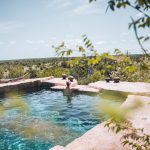The most energy-efficient hot tubs make good use of the laws of thermodynamics. Luckily, you don’t have to be a physics professor to save money on heating your spa. A little knowledge will help you select an energy-saving, eco-friendly spa. We’ll also show you how to make an older tub more energy efficient.
When Shopping for a New Spa
Modern spas are now built with better insulation and cleaner designs. Ideal hot tubs focus on optimized circulation, avoiding unnecessary options that may take a toll on your electric bill.
Although air blowers were more popular in the past, some spa manufacturers still include these dated forced air systems. Since noisy blowers have a high power demand and rapidly cool the water, we don’t recommend them on new spas. Controllable air-induction jets make blowers unnecessary.
Spa Covers
Spa covers are one of the most integral parts of maintaining a low-cost, energy efficient spa. Heat rises, so most heat is lost through the top of the hot tub. Investing in a well-made, heat-retaining cover can make a huge difference.
The flimsy, poor quality covers that some spa manufacturers use absorb water quickly and often fail within the first year. Water-logged covers have almost no insulating ability and force the equipment to work harder to regulate the temperature. This means not only a higher energy cost, but shorter life for pumps and other costly components.
When purchasing a replacement spa cover, choose options to increase insulating value and longevity. Double wrapped foam cores and full-length padded seals at the hinges offer increased protection and insulation.
Even with these useful enhancements, radiant heat will still be lost through the foam in standard tops.
This reflective metalized shield inside the vapor barrier bounces heat back into your hot tub. Similar to foil-backed home insulation, this inexpensive upgrade pays for itself many times over in energy savings.
You wouldn’t build an energy efficient home just to leave the front door open a crack. Similarly, heat can escape through small gaps between the spa cover and the shell, wasting energy.
Prevent gaps by keeping straps snug and latched when the spa is not in use. If latches are broken, missing, or inadequate, replacement spa cover locks can easily be installed on existing covers.
Consider installing additional tie-down straps to further protect against heat loss and keep the spa cover secure during windstorms.
Floating Thermal Blanket
Even with a great spa cover, evaporation between the water surface and the bottom of the cover results in heat-loss. Using a floating thermal blanket reduces heat loss from evaporation by up to 95%. As an added benefit, spa blankets help protect your spa cover from chemical damage.
Creating Windbreaks
Wind significantly decreases the spa water temperature while the spa is in use. Further, improperly sealed cabinets and spa covers allow gusts to penetrate warm air pockets necessary for insulating. Installing privacy walls, fencing, hedges, or using a coverall can protect the spa from drafts.
Spa Control Settings
The settings on your spa controls can be an effective tool in energy conservation. Most spas can be set to 104°F, but consider reducing the temperature to 102°F or lower if it suits you. It takes a lot more power to maintain hot water at higher temperatures.
Many spa controls have energy saving settings for when you are away from home. Before vacation, set your spa controls to a preset away mode or turn the heat down. In summer, you can turn the heat to the lowest setting or off. Some heat is necessary during winter to protect the spa from freeze damage.
If your power-utility company offers reduced electric rates during off-peak hours, adjust heating/filtration cycles accordingly to keep costs down.
Air Jets and Lights
While opening air valves on your spa may increase the massage power, they also lower the water temperature over time. Close these valves after bathing so that cold air is not being introduced into the spa while not in use.
Long-lasting LED lights use about 80% less energy than standard lights, and our Color-changing LEDs fit in most light fixtures. Even with energy efficient LEDs, be sure to turn the lights off before you leave the spa.
Filter Cartridges and Plumbing System
Dirty, aged filter cartridges overwork pumps and reduce water flow, diminishing efficiency. Soak filters overnight with a non-foaming filter cleanser every 3-4 months.
Rotate two sets of filters, so a clean and dry spare can be installed with each water change. This will extend the life of your filters and keep water circulating more freely.
Using a hot tub safe plumbing cleaner before draining the water to clear any residue in the plumbing or on the heater element. Heater scale formation wastes energy because it reduces the ability of the element to exchange heat with the water.
After refilling, adjust pH and Total Alkalinity to the correct range to prevent formation of scale. Just as a clogged filter will increase energy consumption, so will congested pipes. These small steps will also make your water cleaner and easier to balance upon fill-up.
Water loss means heat loss, so repair any leaks and adjust jets to keep water splash-out to a minimum. Test your spa, and maintaining balance and sanitizer, so the spa only needs to be drained every 3-4 months.
Upgrading from Obsolete, Outdated Spas
Sometimes, efficiency cannot be feasibly improved on a spa that’s just too old to hold the heat. If your tub is a power hog and a financial drain, replace it with a modern, well-designed, eco-friendly, efficient model.




